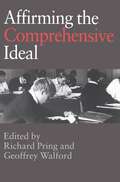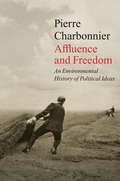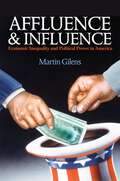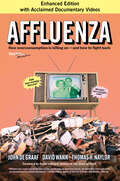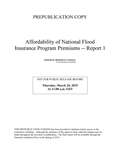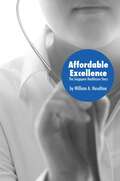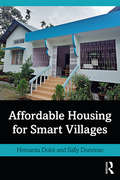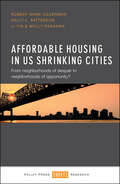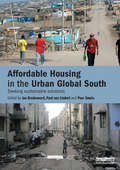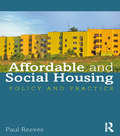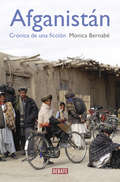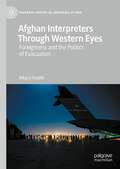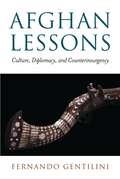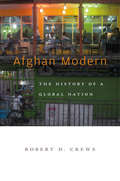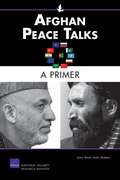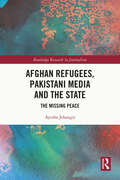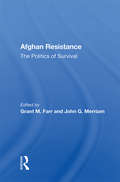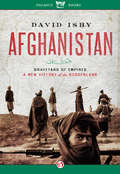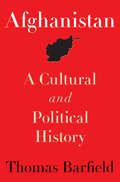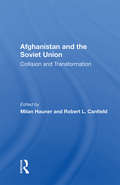- Table View
- List View
Affirming the Comprehensive Ideal
by Richard PringExamines the ideals which lay behind the development of comprehensive schools. Written by 14 British educationalists, this text considers the evidence and suggests how further progress might be made within the moral framework of secondary education for all, irrespective of background or ability. The text includes an afterword by the Rt Hon John Prescott, MP, Deputy Leader of the Labour Party.
Affluence and Freedom: An Environmental History of Political Ideas
by Pierre CharbonnierIn this pathbreaking book, Pierre Charbonnier opens up a new intellectual terrain: an environmental history of political ideas. His aim is not to locate the seeds of ecological thought in the history of political ideas as others have done, but rather to show that all political ideas, whether or not they endorse ecological ideals, are informed by a certain conception of our relationship to the Earth and to our environment. The fundamental political categories of modernity were founded on the idea that we could improve on nature, that we could exert a decisive victory over its excesses and claim unlimited access to earthly resources. In this way, modern thinkers imagined a political society of free individuals, equal and prosperous, alongside the development of industry geared towards progress and liberated from the Earth’s shackles. Yet this pact between democracy and growth has now been called into question by climate change and the environmental crisis. It is therefore our duty today to rethink political emancipation, bearing in mind that this can no longer draw on the prospect of infinite growth promised by industrial capitalism. Ecology must draw on the power harnessed by nineteenth-century socialism to respond to the massive impact of industrialization, but it must also rethink the imperative to offer protection to society by taking account of the solidarity of social groups and their conditions in a world transformed by climate change. This timely and original work of social and political theory will be of interest to a wide readership in politics, sociology, environmental studies and the social sciences and humanities generally.
Affluence and Influence: Economic Inequality and Political Power in America
by Martin GilensWhy policymaking in the United States privileges the rich over the poorCan a country be a democracy if its government only responds to the preferences of the rich? In an ideal democracy, all citizens should have equal influence on government policy—but as this book demonstrates, America's policymakers respond almost exclusively to the preferences of the economically advantaged. Affluence and Influence definitively explores how political inequality in the United States has evolved over the last several decades and how this growing disparity has been shaped by interest groups, parties, and elections.With sharp analysis and an impressive range of data, Martin Gilens looks at thousands of proposed policy changes, and the degree of support for each among poor, middle-class, and affluent Americans. His findings are staggering: when preferences of low- or middle-income Americans diverge from those of the affluent, there is virtually no relationship between policy outcomes and the desires of less advantaged groups. In contrast, affluent Americans' preferences exhibit a substantial relationship with policy outcomes whether their preferences are shared by lower-income groups or not. Gilens shows that representational inequality is spread widely across different policy domains and time periods. Yet Gilens also shows that under specific circumstances the preferences of the middle class and, to a lesser extent, the poor, do seem to matter. In particular, impending elections—especially presidential elections—and an even partisan division in Congress mitigate representational inequality and boost responsiveness to the preferences of the broader public.At a time when economic and political inequality in the United States only continues to rise, Affluence and Influence raises important questions about whether American democracy is truly responding to the needs of all its citizens.
Affluence, Austerity and Electoral Change in Britain
by Paul Whiteley Harold D. Clarke David Sanders Marianne C. Stewart Paul Whiteley Harold D. Clarke David SandersAffluence, Austerity and Electoral Change in Britain investigates the political economy of party support for British political parties since Tony Blair led New Labour to power in 1997. Using valence politics models of electoral choice and marshalling an unprecedented wealth of survey data collected in the British Election Study's monthly Continuous Monitoring Surveys, the authors trace forces affecting support for New Labour during its thirteen years in office. They then study how the recessionary economy has influenced the dynamics of party support since the Conservative-Liberal Democrat Coalition came to power in May 2010 and factors that shaped voting in Britain's May 2011 national referendum on changing the electoral system. Placing Britain in comparative perspective with cross-national survey data gathered in the midst of the worst recession since the 1930s, the authors investigate how the economic crisis has affected support for incumbent governments and democratic politics in over twenty European countries.
Affluenza: How Overconsumption Is Killing Us—and How to Fight Back
by David Wann Thomas H. Naylor John de GraafNEW EDITION, REVISED AND UPDATEDaffluenza, n. a painful, contagious, socially transmitted condition of overload, debt, anxiety, and waste resulting from the dogged pursuit of more.We tried to warn you! The 2008 economic collapse proved how resilient and dangerous affluenza can be. Now in its third edition, this book can safely be called prophetic in showing how problems ranging from loneliness, endless working hours, and family conflict to rising debt, environmental pollution, and rampant commercialism are all symptoms of this global plague. The new edition traces the role overconsumption played in the Great Recession, discusses new ways to measure social health and success (such as the Gross Domestic Happiness index), and offers policy recommendations to make our society more simplicity-friendly. The underlying message isn't to stop buying—it's to remember, always, that the best things in life aren't things.
Affordability of National Flood Insurance Program Premiums: Report 1
by Committee on the Affordability of National Flood Insurance Program PremiumsThe National Flood Insurance Program (NFIP) is housed within the Federal Emergency Management Agency (FEMA) and offers insurance policies that are marketed and sold through private insurers, but with the risks borne by the U. S. federal government. NFIP's primary goals are to ensure affordable insurance premiums, secure widespread community participation in the program, and earn premium and fee income that covers claims paid and program expenses over time. In July 2012, the U. S. Congress passed the Biggert-Waters Flood Insurance Reform and Modernization Act (Biggert-Waters 2012), designed to move toward an insurance program with NFIP risk-based premiums that better reflected expected losses from floods at insured properties. This eliminated policies priced at what the NFIP called "pre-FIRM subsidized" and "grandfathered. " As Biggert-Waters 2012 went into effect, constituents from multiple communities expressed concerns about the elimination of lower rate classes, arguing that it created a financial burden on policy holders. In response to these concerns Congress passed The Homeowner Flood Insurance Affordability Act of 2014 (HFIAA 2014). The 2014 legislation changed the process by which pre-FIRM subsidized premiums for primary residences would be removed and reinstated grandfathering. As part of that legislation, FEMA must report back to Congress with a draft affordability framework. "Affordability of National Flood Insurance Program Premiums: Report 1" is the first part of a two-part study to provide input as FEMA prepares their draft affordability framework. This report discusses the underlying definitions and methods for an affordability framework and the affordability concept and applications. "Affordability of National Flood Insurance Program Premiums" gives an overview of the demand for insurance and the history of the NFIP premium setting. The report then describes alternatives for determining when the premium increases resulting from Biggert-Waters 2012 would make flood insurance unaffordable.
Affordable Excellence
by William A. HaseltineThis is the story of the Singapore healthcare system: how it works, how it is financed, its history, where it is going, and what lessons it may hold for national health systems around the world. Singapore ranks sixth in the world in healthcare outcomes, yet spends proportionally less on healthcare than any other high-income country. This is the first book to set out a comprehensive system-level description of healthcare in Singapore, with a view to understanding what can be learned from its unique system design and development path.The lessons from Singapore will be of interest to those currently planning the future of healthcare in emerging economies, as well as those engaged in the urgent debates on healthcare in the wealthier countries faced with serious long-term challenges in healthcare financing. Policymakers, legislators, public health officials responsible for healthcare systems planning, finance and operations, as well as those working on healthcare issues in universities and think tanks should understand how the Singapore system works to achieve affordable excellence.
Affordable Excellence: The Singapore Health System
by William A. HaseltineThis is the story of the Singapore healthcare system: how it works, how it is financed, its history, where it is going, and what lessons it may hold for national health systems around the world. Singapore ranks sixth in the world in healthcare outcomes, yet spends proportionally less on healthcare than any other high-income country. This is the first book to set out a comprehensive system-level description of healthcare in Singapore, with a view to understanding what can be learned from its unique system design and development path.The lessons from Singapore will be of interest to those currently planning the future of healthcare in emerging economies, as well as those engaged in the urgent debates on healthcare in the wealthier countries faced with serious long-term challenges in healthcare financing. Policymakers, legislators, public health officials responsible for healthcare systems planning, finance and operations, as well as those working on healthcare issues in universities and think tanks should understand how the Singapore system works to achieve affordable excellence.
Affordable Excellence: The Singapore Healthcare Story
by William A. HaseltineThis is the story of the Singapore healthcare system: how it works, how it is financed, its history, where it is going, and what lessons it may hold for national health systems around the world. Singapore ranks sixth in the world in healthcare outcomes, yet spends proportionally less on healthcare than any other high-income country. This is the first book to set out a comprehensive system-level description of healthcare in Singapore, with a view to understanding what can be learned from its unique system design and development path.The lessons from Singapore will be of interest to those currently planning the future of healthcare in emerging economies, as well as those engaged in the urgent debates on healthcare in the wealthier countries faced with serious long-term challenges in healthcare financing. Policymakers, legislators, public health officials responsible for healthcare systems planning, finance and operations, as well as those working on healthcare issues in universities and think tanks should understand how the Singapore system works to achieve affordable excellence.
Affordable Housing for Smart Villages
by Sally Donovan Hemanta DoloiThis book initiates a fresh discussion of affordability in rural housing set in the context of the rapidly shifting balance between rural and urban populations. It conceptualises affordability in rural housing along a spectrum that is interlaced with cultural and social values integral to rural livelihoods at both personal and community level. Developed around four intersecting themes: explaining houses and housing in rural settings; exploring affordability in the context of aspirations and vulnerability; rural development agendas involving housing and communities; and construction for resilience in rural communities, the book provides an overview of some of the little understood and sometimes counter-intuitive best practices on rural affordability and affordable housing that have emerged in developing economies over the last thirty years. Drawing on practice-based evidence this book presents innovative ideas for harnessing rural potential, and empowering rural communities with added affordability and progressive development in the context of housing and improved living standards. For a student aspiring to work in rural areas in developing countries it is an introduction to and map of some key solutions around the critical area of affordable housing For the rural development professional, it provides a map of a territory they rarely see because they are absorbed in a particular rural area or project For the academic looking to expand their activities into rural areas, especially in rural housing, it provides a handy introduction to a body of knowledge serving 47% of the world's population, and how this differs from urban practice For the policy makers, it provides a map for understanding the dynamics around rural affordability, growth potential and community aspirations helping them to devise appropriate intervention programs on rural housing and development
Affordable Housing in US Shrinking Cities: From Neighborhoods of Despair to Neighborhoods of Opportunity?
by Robert Mark Silverman Kelly L. PattersonGiven the rapid urbanisation of the world’s population, the converse phenomenon of shrinking cities is often overlooked and little understood. Yet with almost one in ten post-industrial US cities shrinking in recent years, efforts by government and anchor institutions to regenerate these cities is gaining policy urgency, with the availability and siting of affordable housing being a key concern. This is the first book to look at the reasons for the failure (and success) of affordable housing experiences in the fastest shrinking cities in the US. Applying quantitative and GIS analysis using data from the US Department of Housing and Urban Development, the authors make recommendations for future place-based siting practices, stressing its importance for ensuring more equitable urban revitalisation. The book will be a valuable resource for academic researchers and students in urban studies, housing and inequality, as well as policy makers.
Affordable Housing in the Urban Global South: Seeking Sustainable Solutions
by Peer Smets Jan Bredenoord Paul Van LindertThe global increase in the number of slums calls for policies which improve the conditions of the urban poor, sustainably. This volume provides an extensive overview of current housing policies in Asia, Africa and Latin America and presents the facts and trends of recent housing policies. The chapters provide ideas and tools for pro-poor interventions with respect to the provision of land for housing, building materials, labour, participation and finance. The book looks at the role of the various stakeholders involved in such interventions, including national and local governments, private sector organisations, NGOs and Community-based Organisations.
Affordable and Social Housing: Policy and Practice
by Paul ReevesAffordable and Social Housing - Policy and Practice is a candid and critical appraisal of current big-ticket issues affecting the planning, development and management of affordable and social housing in the United Kingdom. The successor to the second edition of the established textbook An Introduction to Social Housing, the book includes new chapters, reflecting the focal importance of customer involvement and empowerment, regeneration and the Localism agenda which will have radical impacts on housing provision and tenure, as well as the town and country planning system which enables its development. There is also a new chapter on Housing Law in response to demand for a clear and signposting exposition of this often complex area. Reeves indicates how each theme affects the other, and suggests policy directions on the basis of past successes and failures. Paul Reeves takes a people-centred approach to the subject, describing the themes that have run through provision of social housing from the first philanthropic industrialists in the 19th Century though to the increasingly complex mixture of ownerships and tenures in the present day. The book is ideal for students of housing and social policy, and for housing professionals aiming to obtain qualifications and wanting a broad understanding of the social housing sector.
Afganistán
by Mónica BernabéEn agosto del año 2000, Mònica Bernabé viajó por primera vez a Afganistán con la intención de conocer de primera mano el régimen talibán. Llegó invitada por una mujer afgana a quien había entrevistado en Barcelona tiempo atrás, la presidenta de una asociación clandestina creada para alfabetizar a mujeres y niñas en un momento en el que la educación era algo prohibido para ellas. El libro narra en orden cronológico los principales acontecimientos ocurridos en este país lleno de contradicciones y tan desconocido para nosotros a lo largo de más de una década: la caída del régimen talibán, las consecuencias del 11S o la presencia de las tropas españolas en Afganistán. Mònica Bernabé nos cuenta la verdadera historia de un país que solo se conoce por los tópicos informativos.
Afganistán: Crónica de una ficción
by Mónica BernabéLa historia reciente de Afganistán narrada por la única corresponsal española que vive en el país. Afganistán se ha convertido en un nombre cotidiano sin quererlo, en una imposición política, en un conflicto no deseado que, tras muchos años de lucha, sigue sin resolverse. Mònica Bernabé es la única periodista española que vive en Afganistán, una observadora privilegiada que nos cuenta la historia del país a través de su experiencia y narra los acontecimientos que han marcado una década: desde la caída del régimen talibán en el año 2001 hasta la quema de coranes de 2012, pasando por la violencia endémica contra las mujeres y el mito del burqa, las duras condiciones de vida en el frente, la nueva estrategia de Obama o la realidad de las tropas españolas en el país. Bernabé da voz al pueblo afgano en una crónica extraordinaria que se aleja de toda manipulación mediática y revela la verdad sobre el conflicto que ha conseguido desacreditar la política intervencionista de Occidente.
Afghan Interpreters Through Western Eyes: Foreignness and the Politics of Evacuation (Palgrave Studies in Languages at War)
by Hilary FootittThis book explores how endangered local interpreters in Afghanistan were seen through Western eyes in the period from 2014, when the West drew down the bulk of its military forces, to the summer of 2021, when NATO forces withdrew completely. The author examines how these interpreters were understood and represented by Western governments, militaries, agencies, press and lobby organisations, how the understandings changed over time, and to what extent the representations reflect distinct rationales for intervention/historic relationships with Afghanistan, specific immigration and anti-terrorism policies, and notions of citizenship. The book will be of interest to students and scholars of translation and interpreting, history, war studies, and migration studies.
Afghan Lessons
by Angela Arnone Fernando GentiliniFernando Gentilini served nearly two years as the civilian representative of NATO in Afghanistan, running a counterinsurgency campaign in the wartorn nation. Afghan Lessons is the fascinating story of his mission, a firsthand view of Afghanistan through a kaleidoscope. He explores Afghan history, literature, tradition, and culture to understand some of the most basic questions of Western involvement: What is the purpose? What does an international presence mean, and how can it help?Highlights from Afghan Lessons"This is a book about different worlds, different realities. The reality of everyday life in an unreal world. People that need to be looked after, jobs that need to be done, a country that needs to be restored, all from within the necessary confines of an armed camp. And this in the middle of another reality, which we do not understand, full of things forgotten under decades of war. The keys to this reality lie in the past, perhaps lost." --from the Foreword by Robert Cooper"To tempt me to explore their country, the Afghans kept repeating that there were three different Afghanistans: 'The first is the one you Westerners imagine; another coincides with the city of Kabul; the third is the country of remote provinces, far away from the cities, and of the three, this is the only real Afghanistan.'""'There can be no development without security and no security without development.' ... Everyone said it over and over again, both the civilians and the military, but depending on whether it was said by the former or the latter, the emphasis was placed on the first or second part of the slogan. In all honesty this seemingly obvious concept concealed two contrasting ways of seeing things."
Afghan Lessons
by Fernando GentiliniFernando Gentilini served nearly two years as the civilian representative of NATO in Afghanistan, running a counterinsurgency campaign in the wartorn nation. Afghan Lessons is the fascinating story of his mission, a firsthand view of Afghanistan through a kaleidoscope. He explores Afghan history, literature, tradition, and culture to understand some of the most basic questions of Western involvement: What is the purpose? What does an international presence mean, and how can it help?Highlights from Afghan Lessons"This is a book about different worlds, different realities. The reality of everyday life in an unreal world. People that need to be looked after, jobs that need to be done, a country that needs to be restored, all from within the necessary confines of an armed camp. And this in the middle of another reality, which we do not understand, full of things forgotten under decades of war. The keys to this reality lie in the past, perhaps lost." -from the Foreword by Robert Cooper"To tempt me to explore their country, the Afghans kept repeating that there were three different Afghanistans: 'The first is the one you Westerners imagine; another coincides with the city of Kabul; the third is the country of remote provinces, far away from the cities, and of the three, this is the only real Afghanistan.'""'There can be no development without security and no security without development.' ... Everyone said it over and over again, both the civilians and the military, but depending on whether it was said by the former or the latter, the emphasis was placed on the first or second part of the slogan. In all honesty this seemingly obvious concept concealed two contrasting ways of seeing things."
Afghan Modern: The History of a Global Nation
by Robert D. Crews<p>Rugged, remote, riven by tribal rivalries and religious violence, Afghanistan seems to many a country frozen in time and forsaken by the world. Afghan Modern presents a bold challenge to these misperceptions, revealing how Afghans, over the course of their history, have engaged and connected with a wider world and come to share in our modern globalized age. <p>Always a mobile people, Afghan travelers, traders, pilgrims, scholars, and artists have ventured abroad for centuries, their cosmopolitan sensibilities providing a compass for navigating a constantly changing world. Robert Crews traces the roots of Afghan globalism to the early modern period, when, as the subjects of sprawling empires, the residents of Kabul, Kandahar, and other urban centers forged linkages with far-flung imperial centers throughout the Middle East and Asia. Focusing on the emergence of an Afghan state out of this imperial milieu, he shows how Afghan nation-making was part of a series of global processes, refuting the usual portrayal of Afghans as pawns in the “Great Game” of European powers and of Afghanistan as a “hermit kingdom.” <p>In the twentieth century, the pace of Afghan interaction with the rest of the world dramatically increased, and many Afghan men and women came to see themselves at the center of ideological struggles that spanned the globe. Through revolution, war, and foreign occupations, Afghanistan became even more enmeshed in the global circulation of modern politics, occupying a pivotal position in the Cold War and the tumultuous decades that followed.</p>
Afghan Peace Talks
by James Dobbins James ShinnThe objective of a negotiated peace in Afghanistan has been firmly embraced by most of the potential parties to a treaty. However, arriving at an agreement about the sequencing, timing, and prioritization of peace terms is likely to be difficult, given the divergence in the parties' interests and objectives. The U.S. objective in these negotiations should be a stable and peaceful Afghanistan that neither hosts nor collaborates with terrorists.
Afghan Refugees, Pakistani Media and the State: The Missing Peace (Routledge Research in Journalism)
by Ayesha JehangirDrawing on the frameworks of peace journalism, this book offers new insights into the Pakistani media coverage of Afghan refugees and their forced repatriation from Pakistan. Based on a three-year-study, the author examines the political, social and economic forces that influence and govern the reporting practices of journalists covering the protracted refugee conflict between Pakistan and Afghanistan. Through a critical discourse analysis of the structures of journalistic iterability of Afghan refugees in Pakistan, the author distils four dominant and three emerging frames, and proposes a new teleological turn for peace journalism as deliberative practice, that is to say practice that by promoting transparency and accountability (recognition) and challenging dominant power-proposed narratives and perspectives (resistance) encourages public engagement and participation (cosmopolitan solidarity). The author also privileges an analytical approach that conceptualises the nexus between digital witnessing and peace journalism through the paradigm of cosmopolitanism. The author finds routinely accommodated media narratives of security that represent Afghan refugees as a ‘threat’, a ‘burden’ and the ‘other’ that, through reinforcement, have become an incontestable reality for the public in Pakistan. This book will appeal to those interested in studying and practicing journalism as a conscientious communicative practice that elicits the very public it seeks to inform.
Afghan Resistance: The Politics Of Surivival
by Grant M. Farr John G. MerriamThe people of Afghanistan stand at a crossroads, with resistance to the Soviet occupation entering its eighth year. The question of survival must be weighed against the difficult political choices of fighting or reaching an accommodation with the Soviet-backed Kabul regime. The vast majority choose to continue the struggle--aided in part by covert arms shipments--and to search for a uniquely Afghan nationalism despite rumors of an impending USSR-U.S. deal whereby, in return for Soviet troop withdrawal and cessation of arms aid to the Mujahideen, Afghanistan and Pakistan would become neutral Muslim nations. Drawing on Afghan cultural and historical background, this collection of original essays provides fresh insights into the nature of the Afghan conflict, the country's threatened national infrastructure, the continuing decimation of its citizens, and the prospects for their survival. Showing that popular resistance is not limited to the Mujahideen, or freedom fighters, but encompasses the Afghan people as a whole, the contributors examine the impact of the world's largest refugee population on the shape of the future Afghanistan. Based on their extensive firsthand experience in the region, the contributors provide an interdisciplinary analysis of a country, a people, and a war still too little known to the outside world.
Afghanistan
by David IsbyA startling history of modern Afghanistan--the story of a country caught in a vortex of terror Veteran defense analyst David Isby provides an insightful and meticulously researched look at the current situation in Afghanistan, her history, and what he believes must be done so that the U.S. and NATO coalition can succeed in what has historically been known as "the graveyard of empires." Afghanistan is one of the poorest countries in the world with one of the lowest literacy rates. It is rife with divisions between ethnic groups that dwarf current schisms in Iraq, along with conflicts between rogue factions from Pakistan, with whom relations are increasingly strained. The task of implementing an effective American policy and cementing Afghan rule is hampered by what Isby sees as separate but overlapping conflicts between terrorism, narcotics, and regional rivalries, each presenting separate yet equally challenging issues to resolve. This book provides the road map to overcoming these obstacles and finding a way forward for the U.S. and the Afghan nation.
Afghanistan
by Thomas BarfieldAfghanistan traces the historic struggles and the changing nature of political authority in this volatile region of the world, from the Mughal Empire in the sixteenth century to the Taliban resurgence today. Thomas Barfield introduces readers to the bewildering diversity of tribal and ethnic groups in Afghanistan, explaining what unites them as Afghans despite the regional, cultural, and political differences that divide them. He shows how governing these peoples was relatively easy when power was concentrated in a small dynastic elite, but how this delicate political order broke down in the nineteenth and twentieth centuries when Afghanistan's rulers mobilized rural militias to expel first the British and later the Soviets. Armed insurgency proved remarkably successful against the foreign occupiers, but it also undermined the Afghan government's authority and rendered the country ever more difficult to govern as time passed. Barfield vividly describes how Afghanistan's armed factions plunged the country into a civil war, giving rise to clerical rule by the Taliban and Afghanistan's isolation from the world. He examines why the American invasion in the wake of September 11 toppled the Taliban so quickly, and how this easy victory lulled the United States into falsely believing that a viable state could be built just as easily. Afghanistan is essential reading for anyone who wants to understand how a land conquered and ruled by foreign dynasties for more than a thousand years became the "graveyard of empires" for the British and Soviets, and what the United States must do to avoid a similar fate.
Afghanistan And The Soviet Union: Collision And Transformation
by Milan HaunerSince the dramatic events of a decade ago-the revolutions in Kabul and Teheran, the Soviet invasion of Afghanistan, and the Gulf War- "Greater Central Asia" has recaptured the imagination of academia. Historians, Islamicists, anthropologists, political scientists, and defense analysts began to convene conferences and to produce collective volumes that concentrated on two seemingly unrelated subjects: the continuity and strength of ethnocultural patterns in Muslim Central Asia, on the one hand, and the limited range of U.S. military options for defense of the oil-rich Gulf region against hypothetical Soviet invasion, on the other. The contributors to this volume were asked to focus on the long term significance of the junction between Afghanistan and Soviet Eurasia through the "Midlands" region-a relationship that could have wide implications.
